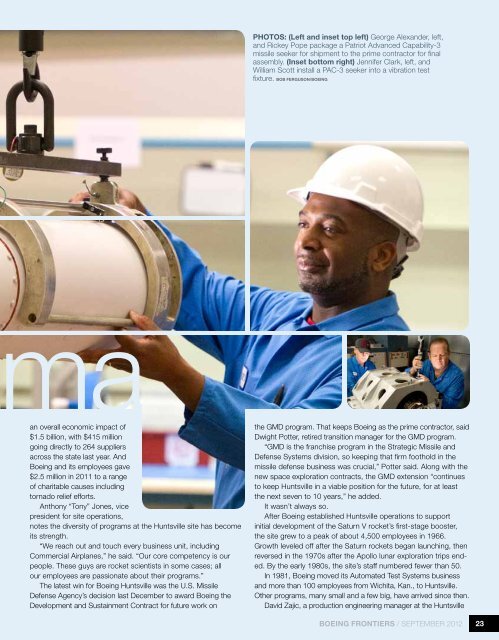Frontiers - Space-Library
Frontiers - Space-Library
Frontiers - Space-Library
Create successful ePaper yourself
Turn your PDF publications into a flip-book with our unique Google optimized e-Paper software.
PHOTOS: (Left and inset top left) George Alexander, left,<br />
and Rickey Pope package a Patriot Advanced Capability-3<br />
missile seeker for shipment to the prime contractor for final<br />
assembly. (Inset bottom right) Jennifer Clark, left, and<br />
William Scott install a PAC-3 seeker into a vibration test<br />
fixture. bob ferguson/boeing<br />
a<br />
an overall economic impact of<br />
$1.5 billion, with $415 million<br />
going directly to 264 suppliers<br />
across the state last year. And<br />
Boeing and its employees gave<br />
$2.5 million in 2011 to a range<br />
of charitable causes including<br />
tornado relief efforts.<br />
Anthony “Tony” Jones, vice<br />
president for site operations,<br />
notes the diversity of programs at the Huntsville site has become<br />
its strength.<br />
“We reach out and touch every business unit, including<br />
Commercial Airplanes,” he said. “Our core competency is our<br />
people. These guys are rocket scientists in some cases; all<br />
our employees are passionate about their programs.”<br />
The latest win for Boeing Huntsville was the U.S. Missile<br />
Defense Agency’s decision last December to award Boeing the<br />
Development and Sustainment Contract for future work on<br />
the GMD program. That keeps Boeing as the prime contractor, said<br />
Dwight Potter, retired transition manager for the GMD program.<br />
“GMD is the franchise program in the Strategic Missile and<br />
Defense Systems division, so keeping that firm foothold in the<br />
missile defense business was crucial,” Potter said. Along with the<br />
new space exploration contracts, the GMD extension “continues<br />
to keep Huntsville in a viable position for the future, for at least<br />
the next seven to 10 years,” he added.<br />
It wasn’t always so.<br />
After Boeing established Huntsville operations to support<br />
initial development of the Saturn V rocket’s first-stage booster,<br />
the site grew to a peak of about 4,500 employees in 1966.<br />
Growth leveled off after the Saturn rockets began launching, then<br />
reversed in the 1970s after the Apollo lunar exploration trips ended.<br />
By the early 1980s, the site’s staff numbered fewer than 50.<br />
In 1981, Boeing moved its Automated Test Systems business<br />
and more than 100 employees from Wichita, Kan., to Huntsville.<br />
Other programs, many small and a few big, have arrived since then.<br />
David Zajic, a production engineering manager at the Huntsville<br />
BOEING FRONTIERS / SEPTEMBER 2012<br />
23
















